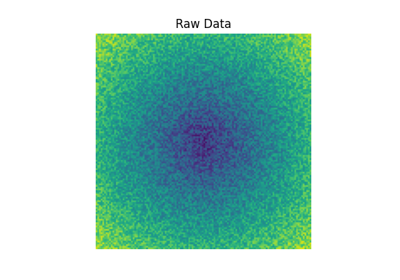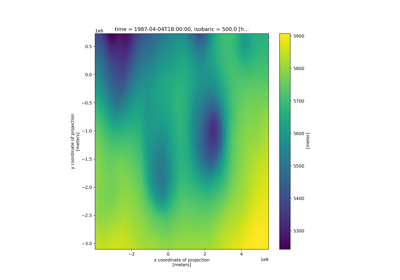smooth_gaussian#
- metpy.calc.smooth_gaussian(scalar_grid, n)[source]#
Filter with normal distribution of weights.
- Parameters:
scalar_grid (
pint.Quantity) – Some n-dimensional scalar grid. If more than two axes, smoothing is only done across the last two.n (int) – Degree of filtering
- Returns:
pint.Quantity– The filtered 2D scalar grid
Notes
This function is a close replication of the GEMPAK function
GWFS, but is not identical. The following notes are incorporated from the GEMPAK source code:This function smooths a scalar grid using a moving average low-pass filter whose weights are determined by the normal (Gaussian) probability distribution function for two dimensions. The weight given to any grid point within the area covered by the moving average for a target grid point is proportional to:
\[e^{-D^2}\]where D is the distance from that point to the target point divided by the standard deviation of the normal distribution. The value of the standard deviation is determined by the degree of filtering requested. The degree of filtering is specified by an integer. This integer is the number of grid increments from crest to crest of the wave for which the theoretical response is 1/e = .3679. If the grid increment is called delta_x, and the value of this integer is represented by N, then the theoretical filter response function value for the N * delta_x wave will be 1/e. The actual response function will be greater than the theoretical value.
The larger N is, the more severe the filtering will be, because the response function for all wavelengths shorter than N * delta_x will be less than 1/e. Furthermore, as N is increased, the slope of the filter response function becomes more shallow; so, the response at all wavelengths decreases, but the amount of decrease lessens with increasing wavelength. (The theoretical response function can be obtained easily–it is the Fourier transform of the weight function described above.)
The area of the patch covered by the moving average varies with N. As N gets bigger, the smoothing gets stronger, and weight values farther from the target grid point are larger because the standard deviation of the normal distribution is bigger. Thus, increasing N has the effect of expanding the moving average window as well as changing the values of weights. The patch is a square covering all points whose weight values are within two standard deviations of the mean of the two-dimensional normal distribution.
The key difference between GEMPAK’s GWFS and this function is that, in GEMPAK, the leftover weight values representing the fringe of the distribution are applied to the target grid point. In this function, the leftover weights are not used.
When this function is invoked, the first argument is the grid to be smoothed, the second is the value of N as described above:
GWFS ( S, N )
where N > 1. If N <= 1, N = 2 is assumed. For example, if N = 4, then the 4 delta x wave length is passed with approximate response 1/e.


